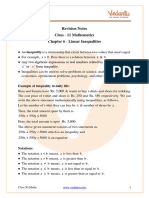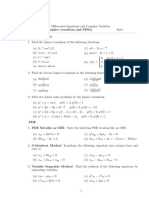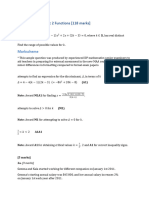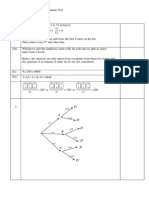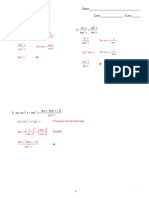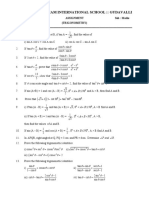0 ratings0% found this document useful (0 votes)
18K viewsNatural Logarithm Notes
The document defines the natural logarithm (ln) as the logarithm to base e of a number. It provides the definition of the natural logarithm, lists some of its key rules and properties, and gives examples of applying the product rule, quotient rule, power rule, and derivatives and integrals of the natural logarithm function. Some key properties covered are that the natural logarithm is the inverse function of the exponential function e^x, its derivative is 1/x, and its integral is x(ln(x)-1)+C.
Uploaded by
katycwiCopyright
© © All Rights Reserved
Available Formats
Download as DOCX, PDF, TXT or read online on Scribd
0 ratings0% found this document useful (0 votes)
18K viewsNatural Logarithm Notes
The document defines the natural logarithm (ln) as the logarithm to base e of a number. It provides the definition of the natural logarithm, lists some of its key rules and properties, and gives examples of applying the product rule, quotient rule, power rule, and derivatives and integrals of the natural logarithm function. Some key properties covered are that the natural logarithm is the inverse function of the exponential function e^x, its derivative is 1/x, and its integral is x(ln(x)-1)+C.
Uploaded by
katycwiCopyright
© © All Rights Reserved
Available Formats
Download as DOCX, PDF, TXT or read online on Scribd
You are on page 1/ 3
Natural Logarithm - ln(x)
Natural logarithm is the logarithm to the base e of a number.
Natural logarithm (ln) definition
Natural logarithm (ln) rules & properties
o Derivative of natural logarithm (ln)
o Integral of natural logarithm (ln)
Graph of ln(x)
Natural logarithms (ln) table
Natural logarithm calculator
Definition of natural logarithm
When
e
y
= x
Then base e logarithm of x is
ln(x) = log
e
(x) = y
The e constant or Euler's number is:
e 2.71828183
Ln as inverse function of exponential function
The natural logarithm function ln(x) is the inverse function of the exponential function e
x
.
For x>0,
f (f
-1
(x)) = e
ln(x)
= x
Or
f
-1
(f (x)) = ln(e
x
) = x
Natural logarithm rules and properties
Rule name Rule Example
Product rule
ln(x y) = ln(x) + ln(y) ln(3 7) = ln(3) + ln(7)
Quotient rule
ln(x / y) = ln(x) - ln(y) ln(3 / 7) = ln(3) - ln(7)
Power rule
ln(x
y
) = y ln(x) ln(2
8
) = 8 ln(2)
ln derivative
f (x) = ln(x) f ' (x) = 1
/ x
ln integral
ln(x)dx = x (ln(x) - 1)
+ C
ln of negative
number
ln(x) is undefined when x
0
ln of zero
ln(0) is undefined
ln of one
ln(1) = 0
ln of infinity
lim ln(x) = ,when x
Logarithm product rule
The logarithm of the multiplication of x and y is the sum of logarithm of x and logarithm of y.
log
b
(x y) = log
b
(x) + log
b
(y)
For example:
log
10
(3 7) = log
10
(3) + log
10
(7)
Logarithm quotient rule
The logarithm of the division of x and y is the difference of logarithm of x and logarithm of y.
log
b
(x / y) = log
b
(x) - log
b
(y)
For example:
log
10
(3 / 7) = log
10
(3) - log
10
(7)
Logarithm power rule
The logarithm of x raised to the power of y is y times the logarithm of x.
log
b
(x
y
) = y log
b
(x)
For example:
log
10
(2
8
) = 8 log
10
(2)
Derivative of natural logarithm
The derivative of the natural logarithm function is the reciprocal function.
When
f (x) = ln(x)
The derivative of f(x) is:
f ' (x) = 1 / x
Integral of natural logarithm
The integral of the natural logarithm function is given by:
When
f (x) = ln(x)
The integral of f(x) is:
f (x)dx = ln(x)dx = x (ln(x) - 1) + C
Ln of 0
The natural logarithm of zero is undefined:
ln(0) is undefined
The limit near 0 of the natural logarithm of x, when x approaches zero, is minus infinity:
Ln of 1
The natural logarithm of one is zero:
ln(1) = 0
Ln of infinity
The limit of natural logarithm of infinity, when x approaches infinity is equal to infinity:
lim ln(x) = , when x
You might also like
- Aakash - Binomial Theorem and Its ApplicationNo ratings yetAakash - Binomial Theorem and Its Application8 pages
- Department of Computer Science & Information Technology University of SargodhaNo ratings yetDepartment of Computer Science & Information Technology University of Sargodha29 pages
- V Best Chapter 1.1 Quadratics - ONLINE PDFNo ratings yetV Best Chapter 1.1 Quadratics - ONLINE PDF16 pages
- XT MATHS Grade 11 Functions Parabolas + LinesNo ratings yetXT MATHS Grade 11 Functions Parabolas + Lines5 pages
- 05 2016 - 2017 H2 Maths Differentiation and Its Applications Notes (Final)No ratings yet05 2016 - 2017 H2 Maths Differentiation and Its Applications Notes (Final)32 pages
- NYJC JC 2 H2 Maths 2011 Mid Year Exam Solutions Paper 1No ratings yetNYJC JC 2 H2 Maths 2011 Mid Year Exam Solutions Paper 110 pages
- Linear Inequalities Class 11 Notes CBSE Maths Chapter 6 (PDF)No ratings yetLinear Inequalities Class 11 Notes CBSE Maths Chapter 6 (PDF)7 pages
- Edexcel GCSE Science P1.5 Generation and Transmission of Electricity Test 12 - 13 TSNo ratings yetEdexcel GCSE Science P1.5 Generation and Transmission of Electricity Test 12 - 13 TS14 pages
- 1.1 Functions Topic Questions 0606 Set 4 QP MsNo ratings yet1.1 Functions Topic Questions 0606 Set 4 QP Ms17 pages
- Logarithms - Past Edexcel Exam Questions: C Studywell Publications Ltd. 2015No ratings yetLogarithms - Past Edexcel Exam Questions: C Studywell Publications Ltd. 20157 pages
- NJC Math Apgp Lecture Notes Teachers Edition100% (1)NJC Math Apgp Lecture Notes Teachers Edition18 pages
- Wksheet Calculus 1 Differentiation For Ch. 7 P1 & P2 PDFNo ratings yetWksheet Calculus 1 Differentiation For Ch. 7 P1 & P2 PDF39 pages
- (H2 MATH) Chapter 8 - Applications of DifferentiationNo ratings yet(H2 MATH) Chapter 8 - Applications of Differentiation6 pages
- Logarithms: Learning Outcome: at The End of This Topic, Student Should Be Able ToNo ratings yetLogarithms: Learning Outcome: at The End of This Topic, Student Should Be Able To24 pages
- Differentiation: 1. What Is A Derivative?No ratings yetDifferentiation: 1. What Is A Derivative?20 pages
- NJC JC 2 H2 Maths 2011 Mid Year Exam SolutionsNo ratings yetNJC JC 2 H2 Maths 2011 Mid Year Exam Solutions10 pages
- Maths Practice Paper - Answer Key (Stepwise Solutions) - 2021 - 22 PDFNo ratings yetMaths Practice Paper - Answer Key (Stepwise Solutions) - 2021 - 22 PDF17 pages
- Topic 4: Indices and Logarithms: Jacques Text Book (Edition 4) : Section 2.3 & 2.4No ratings yetTopic 4: Indices and Logarithms: Jacques Text Book (Edition 4) : Section 2.3 & 2.422 pages
- Fundamental Trigonometric Functions: Pre Calculus Quarter 2 Week 3 WeeNo ratings yetFundamental Trigonometric Functions: Pre Calculus Quarter 2 Week 3 Wee3 pages
- Help Guide Properties of Triangles Class11No ratings yetHelp Guide Properties of Triangles Class1110 pages
- NEW ESSAY Logarithms - Knowing It All About CalculusNo ratings yetNEW ESSAY Logarithms - Knowing It All About Calculus1 page
- Skill Practice Verifying Trigonometric IdentitiesNo ratings yetSkill Practice Verifying Trigonometric Identities4 pages
- Trigonometry, Height and Distance Question Bank For Aptitude TestNo ratings yetTrigonometry, Height and Distance Question Bank For Aptitude Test27 pages
- KNF1013 - Week 2 Functions II For StudentsNo ratings yetKNF1013 - Week 2 Functions II For Students27 pages
- Section 4-10: Table of Laplace Transforms: Pauls Online NotesNo ratings yetSection 4-10: Table of Laplace Transforms: Pauls Online Notes3 pages
- Transformations Part 2 Polytechnic Maths SEM 1 SolutionsNo ratings yetTransformations Part 2 Polytechnic Maths SEM 1 Solutions7 pages
- Laws of Sines and Cosines: Quiz Freebie!No ratings yetLaws of Sines and Cosines: Quiz Freebie!4 pages
- Calculus For The Life Sciences 2nd Edition by Greenwell Ritchey and Lial ISBN Solution Manual100% (39)Calculus For The Life Sciences 2nd Edition by Greenwell Ritchey and Lial ISBN Solution Manual113 pages
- JEE Main Maths Logarithm Previous Year Questions With Solutions100% (1)JEE Main Maths Logarithm Previous Year Questions With Solutions9 pages





















